wheel SAAB 9-3 2002 Owners Manual
[x] Cancel search | Manufacturer: SAAB, Model Year: 2002, Model line: 9-3, Model: SAAB 9-3 2002Pages: 256, PDF Size: 11.55 MB
Page 3 of 256
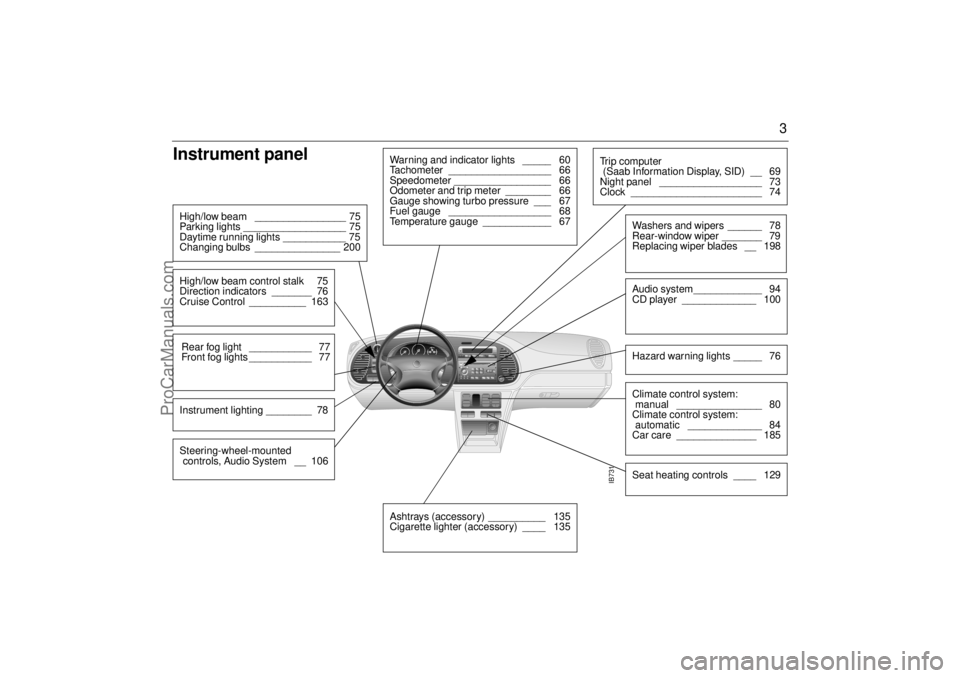
3
Instrument panel High/low beam ________________ 75
Parking lights __________________ 75
Daytime running lights ___________ 75
Changing bulbs _______________ 200High/low beam control stalk 75
Direction indicators _______ 76
Cruise Control __________ 163Rear fog light ___________ 77
Front fog lights ___________ 77Instrument lighting ________ 78
Warning and indicator lights _____ 60
Tachometer __________________ 66
Speedometer _________________ 66
Odometer and trip meter ________ 66
Gauge showing turbo pressure ___ 67
Fuel gauge __________________ 68
Temperature gauge ____________ 67
IB731
Ashtrays (accessory) __________ 135
Cigarette lighter (accessory) ____ 135
Tr i p c o m p u t e r
(Saab Information Display, SID) __ 69
Night panel __________________ 73
Clock _______________________ 74
Washers and wipers ______ 78
Rear-window wiper _______ 79
Replacing wiper blades __ 198Audio system____________ 94
CD player _____________ 100Hazard warning lights _____ 76Climate control system:
manual _______________ 80
Climate control system:
automatic _____________ 84
Car care ______________ 185Seat heating controls ____ 129
Steering-wheel-mounted
controls, Audio System __ 106
ProCarManuals.com
Page 4 of 256
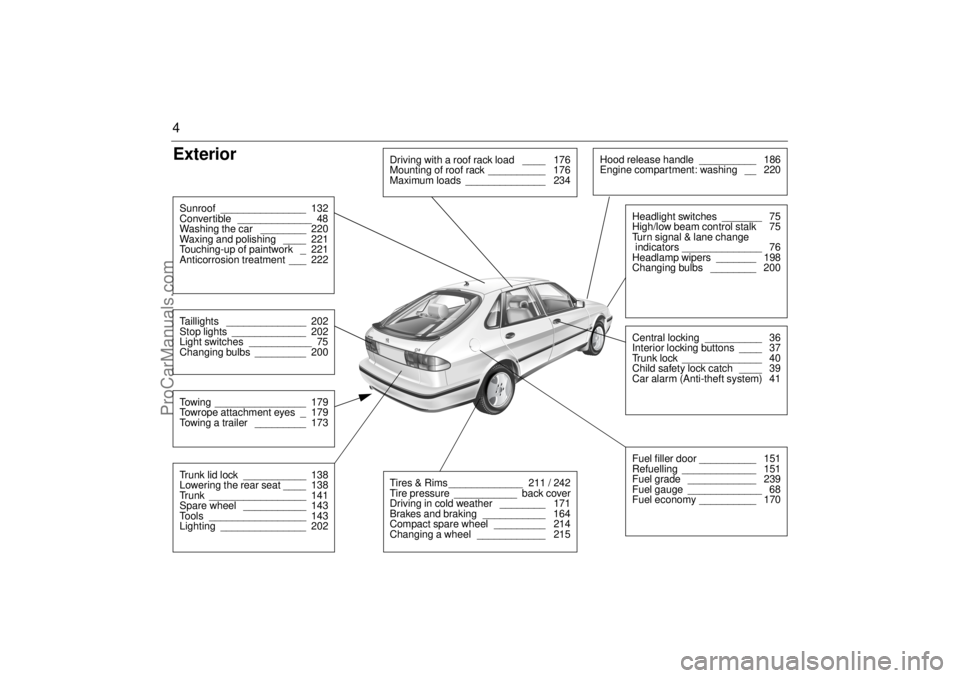
4Exterior Sunroof _______________ 132
Convertible _____________ 48
Washing the car ________ 220
Waxing and polishing ____ 221
Touching-up of paintwork _ 221
Anticorrosion treatment ___ 222Taillights ______________ 202
Stop lights _____________ 202
Light switches ___________ 75
Changing bulbs _________ 200Towing ________________ 179
Towrope attachment eyes _ 179
Towing a trailer _________ 173Trunk lid lock ___________ 138
Lowering the rear seat ____ 138
Trunk _________________ 141
Spare wheel ___________ 143
Tools _________________ 143
Lighting _______________ 202
Driving with a roof rack load ____ 176
Mounting of roof rack __________ 176
Maximum loads ______________ 234
Hood release handle __________ 186
Engine compartment: washing __ 220
Central locking __________ 36
Interior locking buttons ____ 37
Trunk lock ______________ 40
Child safety lock catch ____ 39
Car alarm (Anti-theft system) 41Headlight switches _______ 75
High/low beam control stalk 75
Turn signal & lane change
indicators ______________ 76
Headlamp wipers _______ 198
Changing bulbs ________ 200Fuel filler door __________ 151
Refuelling _____________ 151
Fuel grade ____________ 239
Fuel gauge _____________ 68
Fuel economy __________ 170
Tires & Rims _____________ 211 / 242
Tire pressure ___________ back cover
Driving in cold weather ________ 171
Brakes and braking ___________ 164
Compact spare wheel _________ 214
Changing a wheel ____________ 215
ProCarManuals.com
Page 5 of 256

5
Interior Power steering _________ 241
Steering-wheel adjustment 131
Airbag _________________ 28
Internal rearview mirror ________ 137
Door mirrors ________________ 137
Vanity mirror ________________ 134
Safety belts _____________ 12
Safety-belt care ________ 218
Airbag _________________ 28
Child seats _____________ 19
Child safety lock catch ____ 39Glove compartment _____ 135Manual transmission ____ 155
Automatic transmission __ 156
IB1353
Seat adjustment ________ 124
Safety belts _____________ 12
Seat heating ___________ 129
Rear seat _____________ 138
Folding down the rear seat 138
Child seats _____________ 19
Upholstery: cleaning _____ 219
Interior lighting switch _________ 133
Interior lighting: changing bulbs __ 204
Center console ______________ 130
Electric windows _____________ 130
Sunroof ____________________ 132
Convertible __________________ 48
Ignition switch _______________ 146
Starting the engine ___________ 147
Engine break-in period ________ 155
Parking ____________________ 168
Driving in hot/cold weather _____ 171
ProCarManuals.com
Page 8 of 256
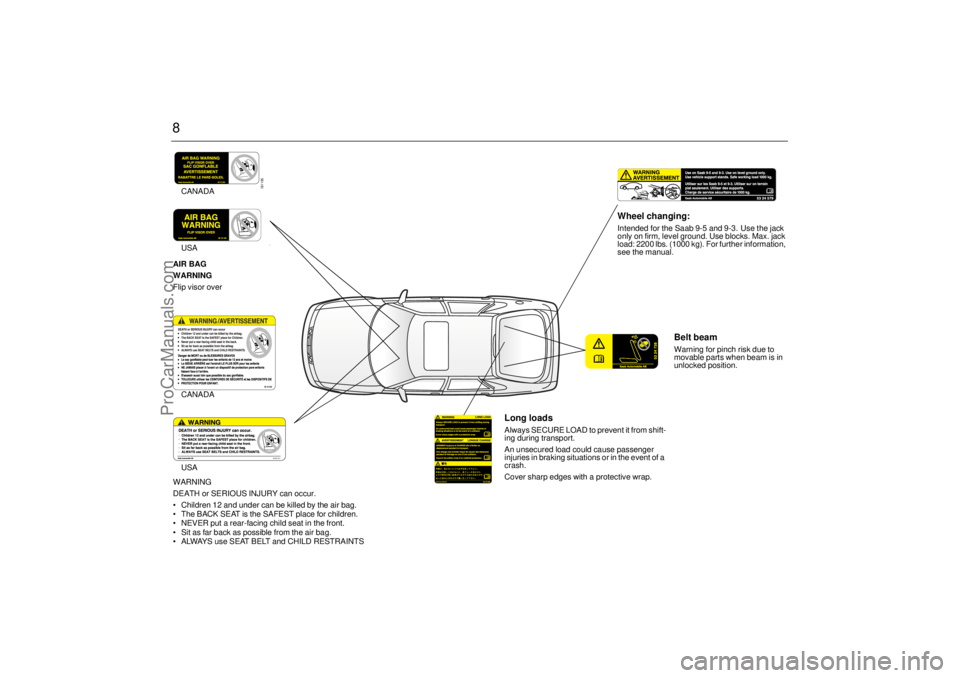
8
Long loads Always SECURE LOAD to prevent it from shift-
ing during transport.
An unsecured load could cause passenger
injuries in braking situations or in the event of a
crash.
Cover sharp edges with a protective wrap.
Belt beam Warning for pinch risk due to
movable parts when beam is in
unlocked position.
Wheel changing: Intended for the Saab 9-5 and 9-3. Use the jack
only on firm, level ground. Use blocks. Max. jack
load: 2200 lbs. (1000 kg). For further information,
see the manual.
AIR BAG
WARNING
Flip visor over
50 10 111
WARNING
DEATH or SERIOUS INJURY can occur.
Children 12 and under can be killed by the air bag.
The BACK SEAT is the SAFEST place for children.
NEVER put a rear-facing child seat in the front.
Sit as far back as possible from the air bag.
ALWAYS use SEAT BELT and CHILD RESTRAINTS
IB1195
USA CANADA
USACANADA
ProCarManuals.com
Page 9 of 256

9
Jack– The jack is designed only for changing a tire or mount-
ing tire snow chains.
– Car must be level and jack must be placed on firm and
level ground.
– Never crawl under car while it is jacked up.
JACKING INSTRUCTIONS
1 Set parking brake and shift transmission to park.
2 Fit top of jack into jacking point next to wheel that to
be changed (See illustration).
3 Crank jack until so that car begins to lift.
4 Remove center cap by inser ting a screw driver under
cap prying up.
5 Using socket wrench in tool kit, loosen wheels bolts
one-half turn.
6 Raise car so that tire clears ground. Loosen wheel
bolts completely and remove wheel.
7 Mount spare wheel and tighten bolts enough so
wheel is not loose.
8 Lower car. Tighten wheel bolts in crosswise order
(See illustration).
Observe max. speed limit for spare tire.
IB934
Soft top, Saab 9-3
Convertible Push the handle in before
driving away.
There would otherwise be
a risk of injury.
Soft top, Saab 9-3 ConvertibleDo not lean over top or sit in the rear seat
while activated.
Brake fluidClean filler cap before removing. Use only Dot
4 fluid from sealed container.
ProCarManuals.com
Page 28 of 256
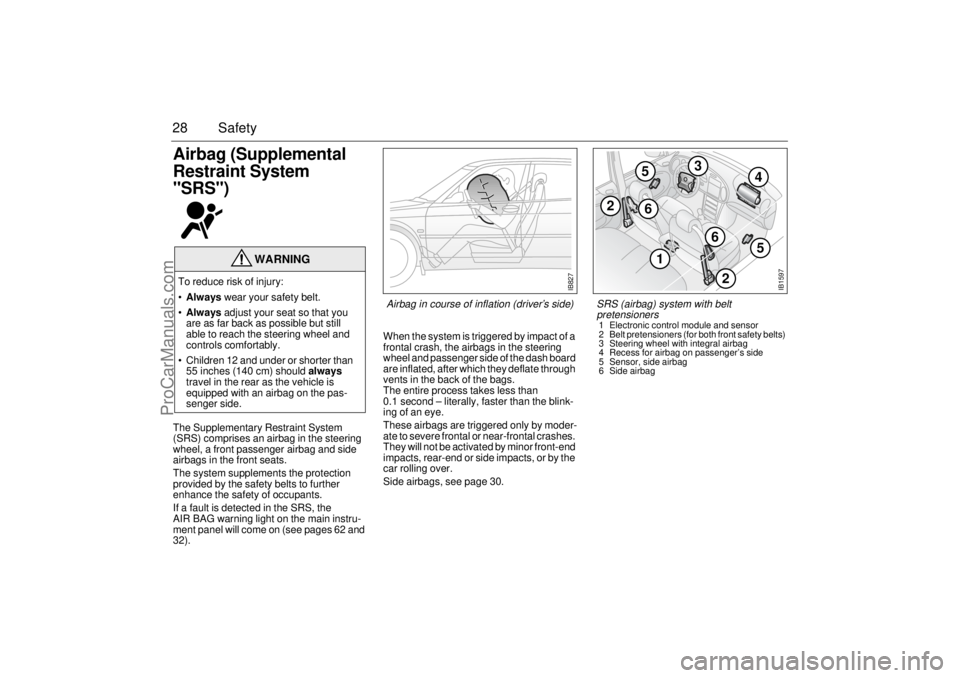
28 SafetyAirbag (Supplemental
Restraint System
"SRS") The Supplementary Restraint System
(SRS) comprises an airbag in the steering
wheel, a front passenger airbag and side
airbags in the front seats.
The system supplements the protection
provided by the safety belts to further
enhance the safety of occupants.
If a fault is detected in the SRS, the
AIR BAG warning light on the main instru-
ment panel will come on (see pages 62 and
32). When the system is triggered by impact of a
frontal crash, the airbags in the steering
wheel and passenger side of the dash board
are inflated, after which they deflate through
vents in the back of the bags.
The entire process takes less than
0.1 second – literally, faster than the blink-
ing of an eye.
These airbags are triggered only by moder-
ate to severe frontal or near-frontal crashes.
They will not be activated by minor front-end
impacts, rear-end or side impacts, or by the
car rolling over.
Side airbags, see page 30.
WARNING
To reduce risk of injury:
Always wear your safety belt.
Always adjust your seat so that you
are as far back as possible but still
able to reach the steering wheel and
controls comfortably.
Children 12 and under or shorter than
55 inches (140 cm) should always
travel in the rear as the vehicle is
equipped with an airbag on the pas-
senger side.
IB827
Airbag in course of inflation (driver’s side)
IB1597
5
1
4
2
6
3
2
6
5
SRS (airbag) system with belt
pretensioners 1 Electronic control module and sensor
2 Belt pretensioners (for both front safety belts)
3 Steering wheel with integral airbag
4 Recess for airbag on passenger’s side
5 Sensor, side airbag
6 Side airbag
ProCarManuals.com
Page 29 of 256
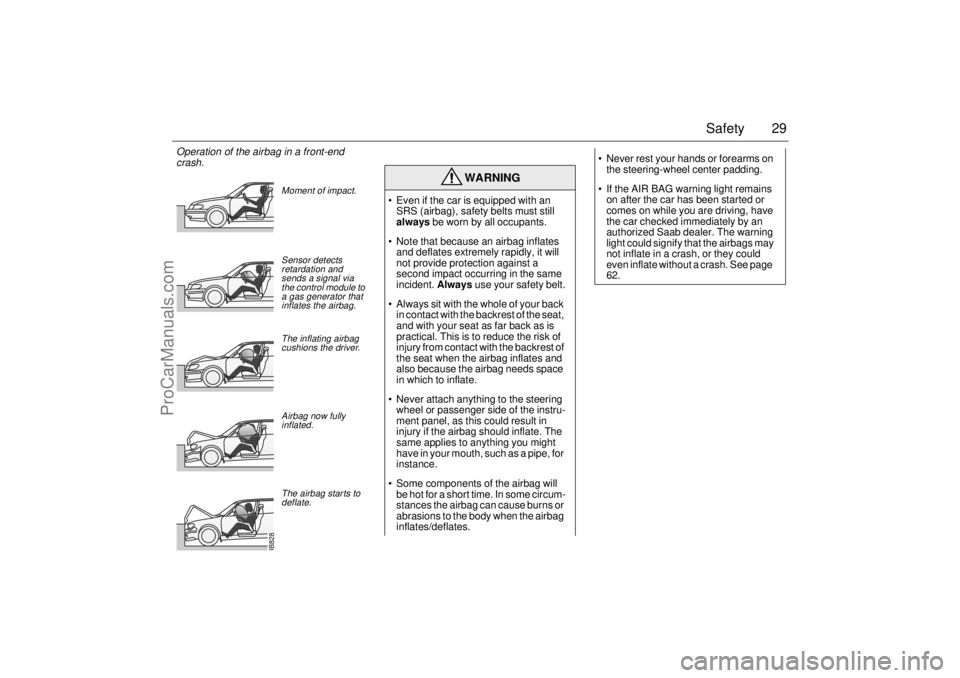
29 Safety
WARNING
Even if the car is equipped with an
SRS (airbag), safety belts must still
always be worn by all occupants.
Note that because an airbag inflates
and deflates extremely rapidly, it will
not provide protection against a
second impact occurring in the same
incident. Always use your safety belt.
Always sit with the whole of your back
in contact with the backrest of the seat,
and with your seat as far back as is
practical. This is to reduce the risk of
injury from contact with the backrest of
the seat when the airbag inflates and
also because the airbag needs space
in which to inflate.
Never attach anything to the steering
wheel or passenger side of the instru-
ment panel, as this could result in
injury if the airbag should inflate. The
same applies to anything you might
have in your mouth, such as a pipe, for
instance.
Some components of the airbag will
be hot for a short time. In some circum-
stances the airbag can cause burns or
abrasions to the body when the airbag
inflates/deflates.
Never rest your hands or forearms on
the steering-wheel center padding.
If the AIR BAG warning light remains
on after the car has been started or
comes on while you are driving, have
the car checked immediately by an
authorized Saab dealer. The warning
light could signify that the airbags may
not inflate in a crash, or they could
even inflate without a crash. See page
62.
Operation of the airbag in a front-end
crash.
Moment of impact.
Sensor detects
retardation and
sends a signal via
the control module to
a gas generator that
inflates the airbag.
The inflating airbag
cushions the driver.
Airbag now fully
inflated.
The airbag starts to
deflate. IB828
ProCarManuals.com
Page 32 of 256

32 SafetyAIR BAG warning light SRS servicing
The SRS must be inspected as part of the
normal service program but otherwise may
be regarded as maintenance-free.
Scrapping or working on airbag and
belt pretensioners
WARNING
If the airbag readiness light stays on
after you start your vehicle, it means
the airbag system may not be working
properly. See page 62.
The airbags in your vehicle may not
inflate in a crash, or they could even
inflate without a crash.
To help avoid injury to yourself or
others, have your vehicle serviced
right away if the airbag readiness light
stays on after you start your vehicle.
WARNING
Under no circumstances should any
modifications be made that affect the
steering wheel or the airbag’s electri-
cal circuitry.
Before starting any welding work on
the car, always disconnect the nega-
tive (–) battery lead and cover the con-
ductor.
Airbags and belt pretensioners must
be deployed under controlled condi-
tions before the car is scrapped or any
of the system’s components are
removed. Airbags or belt pretension-
ers that have been deployed as a
result of a crash must be replaced by
new ones.
Airbag-system components must
never be transferred for use in another
vehicle.
All work involving the scrapping or
replacement of airbags or belt preten-
sioners must only be carried out by
knowledgeable personnel.
ProCarManuals.com
Page 33 of 256

33 Safety
Frequently asked questions on func-
tion of the airbagDo you still need to wear a safety belt if air-
bags are fitted? Yes, always! The airbag merely supple-
ments the car’s normal safety system.
Moreover, the airbag will only be actuated in
a moderate to severe frontal, or near-frontal
crash, which means, of course, that it pro-
vides no protection in minor frontal crashes,
major rear-end or side-on crashes or if the
car rolls over.
The safety belts help to prevent passengers
from being thrown against each other and
being injured.
But they also ensure that, if a crash occurs
in which the airbags are inflated, the airbag
will make the optimum contact with the
occupant, i.e. square on from the front. If the
occupant meets the airbag in an offset posi-
tion, the protection afforded will be reduced.
In addition, airbags provide no protection
against a secondary impact occurring in the
same incident. So there is no doubt about
the benefit of wearing safety belts at all
times.
Do not sit too close to the airbag: it needs
room to inflate.
The airbag inflates very quickly and power-
fully in order to protect an adult person,
before they are thrown forward, in a serious
frontal crash.
How do I position the seat to leave room for
the airbag to inflate?Don’t have your seat too far forward.
Recline the seat back to increase the dis-
tance between you and the airbag. For short
drivers, special accessory pedal extensions
are available through your Saab dealer.
Airbags inflate extremely rapidly and with
great force - to be fast enough to protect an
adult in the seat. When do the airbags in the steering wheel
and passenger side of the dash board
inflate? The airbag will only be inflated under certain
predetermined conditions in a moderate to
severe frontal, or near-frontal crash,
depending on such factors as the force and
angle of the impact, the speed of the car on
impact, and the resistance to deformation of
the impacting object.
The airbag can only be activated once in the
same incident.
Do not attempt to drive the car after an
airbag has been inflated, even if it is possi-
ble.
What won’t trigger the airbag? The airbag will not be activated in all
front-end crashes. For instance, if the car
has hit something relatively soft and yielding
(e.g. a snow drift or a hedge) or a solid
object at a low impact speed, the airbag will
not necessarily be triggered. How loud is the inflation? The noise of the inflation is certainly loud,
but it is very short-lived and will not damage
your hearing. For a short time afterwards
you could experience a buzzing noise in
your ears.
Most people who have experienced it
cannot remember the noise of the inflation
at all - all they remember is the noise of the
crash. Can you still use a child seat in the front if a
passenger airbag is installed? Definitely not!
Children 12 and under can be injured or
killed by the airbag.
The BACK SEAT is the SAFEST place for
children.
NEVER put a child seat in the front.
ProCarManuals.com
Page 52 of 256
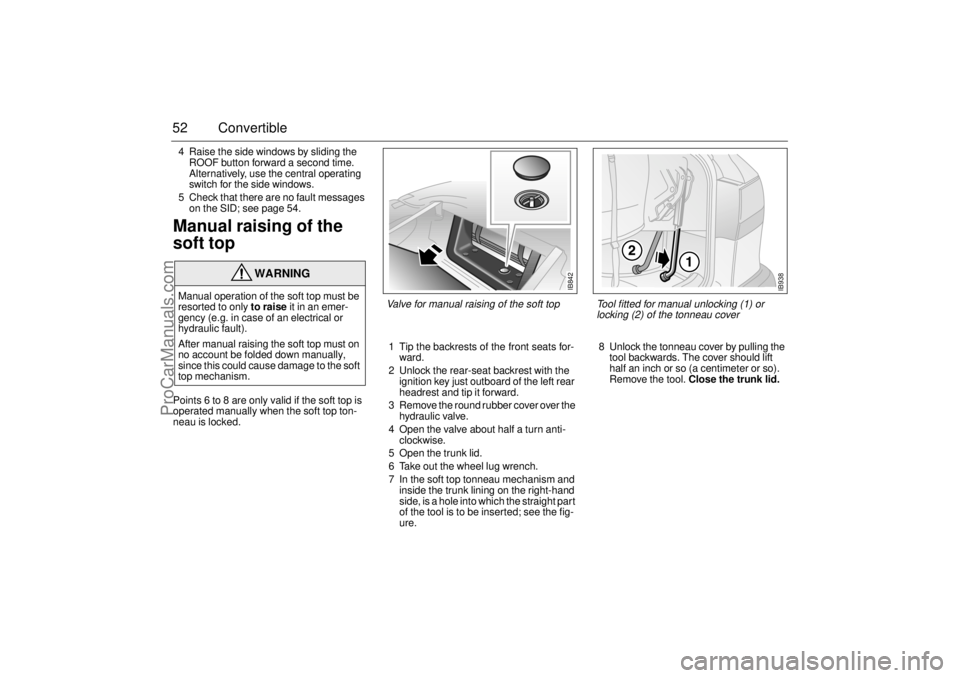
52 Convertible4 Raise the side windows by sliding the
ROOF button forward a second time.
Alternatively, use the central operating
switch for the side windows.
5 Check that there are no fault messages
on the SID; see page 54.Manual raising of the
soft topPoints 6 to 8 are only valid if the soft top is
operated manually when the soft top ton-
neau is locked.1 Tip the backrests of the front seats for-
ward.
2 Unlock the rear-seat backrest with the
ignition key just outboard of the left rear
headrest and tip it forward.
3 Remove the round rubber cover over the
hydraulic valve.
4 Open the valve about half a turn anti-
clockwise.
5 Open the trunk lid.
6 Take out the wheel lug wrench.
7 In the soft top tonneau mechanism and
inside the trunk lining on the right-hand
side, is a hole into which the straight part
of the tool is to be inserted; see the fig-
ure. 8 Unlock the tonneau cover by pulling the
tool backwards. The cover should lift
half an inch or so (a centimeter or so).
Remove the tool. Close the trunk lid.
WARNING
Manual operation of the soft top must be
resorted to only to raise it in an emer-
gency (e.g. in case of an electrical or
hydraulic fault).
After manual raising the soft top must on
no account be folded down manually,
since this could cause damage to the soft
top mechanism.
Valve for manual raising of the soft top
IB842
IB938
Tool fitted for manual unlocking (1) or
locking (2) of the tonneau cover
ProCarManuals.com